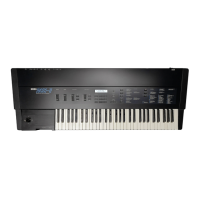.Example applications of modes
t To just listen.
You can listen to the sound that you sampled or
created.
Sample made
I
"\
Create waveform
mode
I I
[2]To set up a patch (create a tone color).
You use the VC At VCF, And other parameters to pro
cess the basic sound that you sampled or created.
You can then use the program that you have made.
Sample mode
..
...
4'
Program ] ,-4
parametmy_ j --•••• j
Create waveform
mode
[Program parameter
¡mode
/
/
\ •,
I (-
•' i
3
To make the raw materials for sound sources.
Sample mode
Save the basic sounds to disk.
Create wavelorm
mode
4_To process the raw materials.
Process the sound that you saved in the previous
step, then save it to disk again.
5; To make a sound source.
Save sampled or created sound to disk as a multi-
sound. Or assemble sounds made in steps [3j and ¡4
and save them as a multisound on disk.
6 Making a system
Take the multisounds that you made in step |S|t and
assign them to OSC-1 and O SC-2 using the program
parameters. Write to program memory if you want to
save a program. After completing your program and
multisound collection, write the whole thing to disk by
using the save system function.
\
Edit sample mode
T
Sample mode
_ n
------------------
«
. V ™
Mult iso und mode
-----------------
n — —
— ^
c
/ N
Create wavelorm
mode
is )
\
•s ..
T
.. .V
_______
\ V-
>— 7 /
L'- 2
MuII¡sound mode
----------• r
----------
1
■ i
Muftisound mode
1 1
W
l
...
1< .12
7 7 7
System mode
1
Program parameter
mode
----------------
ir r -
(write)
A
Sound
MuJtisound
- >
V
System
• V '' J

